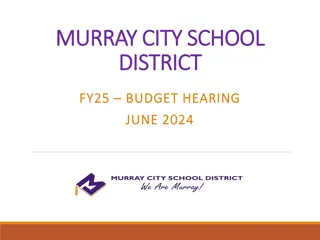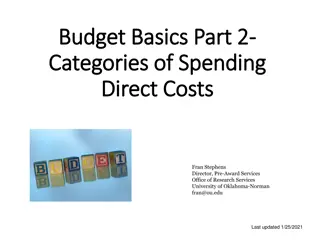Clayton State University Budget Process Overview
Clayton State University follows a detailed budget build process where all funding requests align with strategic priorities. The process involves input from Vice Presidents, Budget Office, and a Planning & Budget Advisory Council, with final decisions made by the President. Various funding sources and budget considerations are outlined, highlighting the importance of fiscal management and adherence to state guidelines.
Download Presentation

Please find below an Image/Link to download the presentation.
The content on the website is provided AS IS for your information and personal use only. It may not be sold, licensed, or shared on other websites without obtaining consent from the author. Download presentation by click this link. If you encounter any issues during the download, it is possible that the publisher has removed the file from their server.
E N D
Presentation Transcript
Open Budget Meeting April 25, 2019
Open Budget Meeting CLAYTON STATE UNIVERSITY BUDGET BUILD PROCESS Overall All funding requests must be in alignment with the university s strategic priorities. The use of funds and support of the University s mission from the previous year(s) is considered in developing future budgets. Instructions and criteria for funding requests will be distributed at the start of the budget build process. The budget office will provide reports and timelines to assist in the preparation of funding requests. General Funds Process: I. II. Each Vice President will submit funding requests for the new fiscal year. Informal meeting occurs with each Vice President and the President, Vice President for Business and Operations, Assistant Vice President of Budget and Finance and the Director of Budgets; where the VP discusses their budget needs for the next year. Data gathered from sessions will be compiled and distributed to the Planning & Budget Advisory Council (PBAC). Each Vice President will be given the opportunity to review their request(s) before the PBAC meeting. Then each VP s request goes before the PBAC members for discussion and to answer any questions that the PBAC may have. PBAC members will review the requests in light of the institution s strategic priorities and assign each request as A; B; C; or D priority. Each priority level is assigned a point value: (5) A; (3) B; (2) C; (1) D. All voting sheets are then tallied and results reported to the PBAC. Results of the priority assignment are reported to the President as recommendations for funding. The President retains final decision making authority as to what is funded in the new budget. III. IV. V. VI. VII. VIII. IX. Other Funds: I. Each director and/or VP will present their budget to the Vice President for Business and Operations, Assistant Vice President of Budget and Finance and the Director of Budgets. The President may elect to attend. The proposed budget will be reviewed for reasonableness and support of the strategic plan. The proposed budget requests/recommendations will be presented to the President for final approval. II. III. Budget Finalization: The Vice President for Business and Operations, Assistant Vice President of Budget and Finance and the Director of Budgets will conduct a final review for accuracy and completeness and then post information on the Budget and Finance and the Planning & Budget Advisory Council Websites. The Board of Regents processes will be followed for submission and implementation. 3
Clayton State Universitys Resources State Appropriation Tuition 60.9% State 1% Institutional Fee and Course Fees 18% 27% 1% Auxiliary Services & Student Life 39.1% Other 2% 0% Continuing Education Indirect Funds 17% Technology 29% Restricted 5% MRR Restrictions Realities Uses Prudent fiscal management required for all sources State Appropriation varies Focus on Financial Ratios Economic conditions have a direct impact on our ability to collect the revenues necessary to satisfy the needs and obligations of the University Salaries and Wages Utilities Supplies and Equipment Technology Facilities and Maintenance Public Safety Campus Activities and Services Capital funds can not be used to pay for salaries and wages State procurement guidelines must be followed Student fees must be used in conjunction with specific services 4
FY19 USG STATE APPROPRIATIONS 1 2 3 4 5 6 7 8 9 University of Georgia Georgia Institute of Technology Georgia State University Augusta University Kennesaw State University Georgia Southern University University of North Georgia University of West Georgia Georgia Gwinnett College Valdosta State University Columbus State University Georgia College & State University Middle Georgia State University Albany State University Clayton State University Savannah State University Abraham Baldwin Agricultural College Fort Valley State University Georgia Highlands College Dalton State College College of Coastal Georgia Georgia Southwestern State University Gordon State College South Georgia State College Atlanta Metropolitan State College East Georgia State College $396,427,057 $291,296,642 $275,716,404 $209,378,976 $148,941,534 $140,001,902 $79,779,895 $64,401,237 $58,096,732 $50,878,036 $42,996,424 $38,476,393 $34,924,916 $30,252,949 $27,229,079 $25,105,384 $24,619,899 $23,080,885 $19,733,508 $17,993,729 $16,757,098 $14,958,663 $12,610,025 $11,442,667 $10,321,200 $9,866,396 10 11 12 13 14 15 16 17 18 19 20 21 22 23 24 25 26 5
Open Budget Meeting STATE APPROPRIATION & TUITION TRENDS FY15 - FY19 Fiscal Year State Appropriation Tuition FY15 $24,067,121 $27,333,575 FY16 $25,198,595 $27,831,086 FY17 $24,687,217 $28,129,766 FY18 $25,539,423 $28,641,372 FY19 $27,229,079 $29,088,093* * FY19 Tuition is projected 6
Open Budget Meeting Fall Enrollment 2012-2018 8,000 7,261 7,140 7,038 7,022 7,012 7,003 6,996 7,000 6,537 6,463 6,087 5,943 5,778 5,768 6,000 5,648 5,000 4,000 3,000 2,000 949 787 777 1,000 644 545 448 441 441 430 425 390 368 332 271 0 Fall 2012 Fall 2013 Fall 2014 Undergraduate Fall 2015 Fall 2016 Fall 2017 Linear (Undergraduate) Fall 2018 MOWR/Dual Enrollment Graduate Total 7
Open Budget Meeting Fees & Changes Mandatory Fees No changes Special Institutional Fees No changes Other Fees Distance Learning-2nd phase of reduction at an additional 33.3% 8
Open Budget Meeting FY 2019 FY 2020 Approved Rate Description BSN Program Fee (Per Semester Nursing Majors) Family Nurse Practitioner Program Fee (paid 1st semester upon acceptance into program) Family Nurse Practitioner Course Fee Teacher Education Practicum Telecourse/Online Course Fee (Capped at $75/semester) $283 $1,029 $283 $481 $469 $300 $15 $0 $300 $25 Family Nurse Practitioner Program Fee reduced to $481 New Family Nurse Practitioner Course (NURS 6690) Fee approved for $469 Online Course Fee Reduced to $15 per course with maximum of $75 per term 9
Open Budget Meeting Total Students FY 2019 Budget vs. Actuals Over/ (Under) Mandatory Fee Chart FY 2018 FY 2019 Laker Card 20 20 (3,516) Technology 57 57 (4,806) Student Activity 60 60 (45,438) Athletic 160 170 (84,519) Health 46 46 (41,892) Parking 34 34 (28,395) Student Activity Center 100 100 (113,740) (322,306) TOTALS Categories that pay less/none: Distance Learning, eCore, Employees/TAP, Fayette County, Henry County, Joint Enrolled, Main Campus - less than 3 hrs, Senior Citizens, WebBSIT 10
Open Budget Meeting Special Institutional Fee FY 2018 FY 2017 FY 2019 (Estimated) $4,500,000 $849,892 $747,745 $590,835 $376,619 $4,000,000 $3,500,000 $3,644,165 $4,292,500 $4,235,000 $3,000,000 $4,275,500 $3,898,881 $4,164,500 $3,544,755 $2,500,000 $3,314,608 $2,000,000 $1,500,000 $1,000,000 $500,000 $- SIF Rate $250 $250 $250 $250 Full Payment Actual Collected 11
Open Budget Meeting FY19 Budget Wrapping Up Available Funds: Estimated Salary & Benefits Savings Sweep $1,604,267 Budget Spend Estimate Sweep $ 300,000 Over realized Tuition Total Funds Available $2,647,267 $ 743,000 Uses of Funds: Tuition Carry Forward $ 870,000 In-Kind SAC & CE (45/200) (Estimated) $ 245,000 Total Uses of Funds $1,115,000 Possible Funds Available for Various Year-End Items Such as One-Time Funding Requests & Unresolved Budget Issues $1,532,267 12
Open Budget Meeting FY19 Year-End Spend Requests Provost (10 Requests) $ 303,038 Enrollment Management (1 Request) $ 55,452 ITS (9 Requests) $ 1,053,600 Business & Operations (55 Requests) $ 1,013,173 University Advancement ( 2 Requests) $ 60,733 Student Affairs (2 Requests) $ 18,550 Spivey (2 Requests) $ 900 Campus Wide (3 Requests) $ 216,000 TOTALS $ 2,721,446 13
Open Budget Meeting UNRESOLVED BUDGET ISSUES Distance Learning-Offering same level of services but at reduced rate $79,591 (Outsource or either hire PT workers to do website updates needed) Website phase 3 was on approved FY18 year end list but not completed $80,000 Stratification to ensure HVAC in Spivey Hall $50,000 Road between main campus and CSU East estimated range $180,000 - $200,000 FY18 Audit Mandated student health insurance Spivey Water Riser Laker Village-Gates Fingerprint machine Change orders associated with the MRR project to replace electrical heating mechanical system at Spivey Hall Utility shortfall Spivey Hall compressor replacement Elevator repairs in Lab Annex Bldg. RAVE Guardian Security system Public Safety fire damage Bad debt related to student accounts in FY18 & FY19 Academic Core transformer total cost 123K which will be reimbursed by GSFIC, but we have to pay up front Woodlands Hall water intrusion UC-Kitchen water leak repairs Electric car charging station repairs Potential litigation settlement Repairs needed in UC for a water leak in the walls $10,800 $3,968 $10,500 $4,096 $15,000 $16,406 $250,000 $36,860 $12,094 $6,467 $80,000 $300,000 $31,000 $10,000 $13,000 $5,000 $9,000 $5,000 Comprehensive Administrative Review Committee Recommendations Unknown Total $1,208,782 - $1,228,782 14
CSU Internal FY20 Budget Meetings FY20 Annual Spend Requests Provost (8 Requests) $548,324 Enrollment Management (4 Requests) $191,342 Business & Operations (7 Requests) $183,850 ITS (5 Requests) $265,680 Student Affairs (4 Requests) $ 91,320 TOTALS $1,280,516 15
Open Budget Meeting Allocation of State Appropriations FY2020 State Appropriation FY 2019 Base Budget $27,229,079 Formula Funding Enrollment and Other Allocations Enrollment Earnings (Loss) $ - Enhancement for Student Success $ 40,000 Partial offset of e-tuition revenue $ 74,300 Maintenance & Operations (M&O) $ 17,072 Merit Allocation $663,709 Health Insurance & Retiree Change $142,542 Teacher s Retirement System $ 26,419 Department of Administrative Services Premiums (DOAS) $ 3,782 Transfers & Other Adjustments (Know More, Borrow Less) $ 31,000 Total of Enrollment and Other Allocations $998,824 Total FY2020 State Funds Budget $28,227,903
CSUs Budget Build FY20 BUDGET BUILD SCENARIO Revenue - 7,000 Fall Enrollment FY20 Budget State Appropriation Tuition Fees & Other General Carry Forward Funds 28,227,903 29,296,125 5,053,900 870,000 63,447,928 Expenditures Updated current budget with 2% Merit Salary Increase 62,305,858 Funding Available to Distribute 1,142,070 Required Funding Items added: University Contingency Increase in software licenses Benefits Associated with 2% Merit Salary Increase Faculty Promotions including benefits Stressors-Public Safety Retention 250,000 73,586 157,231 60,003 8,000 548,820 Additional Funds Available 593,250 17
Open Budget Meeting Fiscal Year 2020 Salary and Wage Administration Guidelines The FY 2020 budget includes $47.0 million in state funds for merit-based pay adjustments and employee recruitment and retention initiatives. The merit increase is to be effective July 1, 2019. The FY 2020 Allocation Sheet reflects the institution s share of these funds. The Board of Regents allocated to each institution funds to provide for salary increases for employees. Salary increases shall be awarded solely on merit, ranging from 0% to a high of 4%. Institution presidents are permitted to narrow the range but may not exceed the range. Institutions are strongly encouraged to give priority to salary increases for teaching faculty. The established salary pool for merit may not exceed 2%. Institutions are required to develop and submit a merit increase matrix demonstrating reasonable distribution based on employee performance. This matrix must align with your established performance management/evaluation rating scale. Across-the-board increases are not permitted. This matrix must be submitted as a part of the FY 2020 budget submission. Employees covered from other fund sources such as sponsored funds and auxiliary funds will be subject to the same policy requirements noted above and must be paid from the corresponding fund source rather than state funds. Institutions will need to identify other appropriate sources to fund salary adjustments related to promotions or position reclassifications, adjustments for targeted populations or adjustments to address market and compression issues. Institutions are encouraged to prioritize adjustments for lower paid employees contingent upon availability of funding. These salary adjustments must be supported by appropriate documentation (e.g., market analysis or internal salary studies) and must be in compliance with Board of Regents Policy 8.2.24 Policy on Salary Administration and Incentive Rewards Program. These salary adjustments may also be effective July 1, 2019. 18
Summer Budget CSU Annual Budget is divided into three parts: Fall/Spring/Summer Summer 2019 Revenue is split about 27% for FY20 and 73% FY19 19
Open Budget Meeting Capital Budget FY 2019 Major Repairs & Renovations(MRR) allocation of $815,000 can be used for these projects: o Improve Campus Egress via CSU East Design Phase III of IV o Replace Electrical Heating System at Spivey Hall Phase III of III Academic Core FF&E $700K Looking Back Academic Core Internal Renovations & Roofs $6.9M Looking Forward New chiller/central plant for Athletics; Spivey Hall; Music; Harry S. Downs Center; and SAC $4.1M 20























